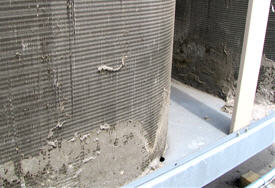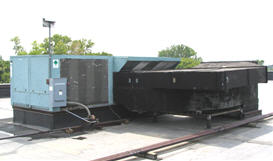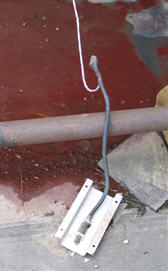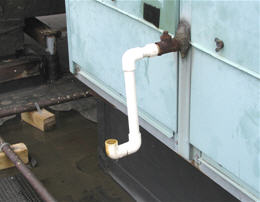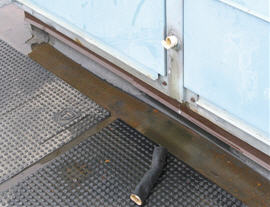HVAC System Energy Audit
Overview
For facilities without a significant process load, space heating and cooling is the primary focus of the Energy Management Program. Even for facilities with large process loads, space heating and cooling should not be ignored, but will have a lower priority for Measures because it represents a smaller percentage of the total energy bill. For background information about space heating systems see Space Heating The general procedure for completing an HVAC system audit is:
- gather existing system information
- estimate existing operating efficiency
- consider efficiency improvements to existing system
- consider replacement options
- evaluate cost and payback of options
Gather Existing System Information
Depending on the size of the facility, this could be a very easy or difficult process. A good way to approach the task is to group equipment by the gas meter that serves it (if possible). This makes it easier later to cross-reference gas usage and connected loads. The data that should be gathered includes:
- equipment location for later identification (ie: Headquarters rooftop; Warehouse 1; etc.)
- equipment brand/make; model if available
- equipment type (ie: Boiler #1; HVAC Unit 2, etc)
- name plate BTU INPUT Rating; Boiler Horse Power; etc.;
- ton rating for cooling equipment, or amp and voltage rating if not marked in tons
- alternate fuel rating, if applicable (generally only boilers are dual-fuel ready)
- estimated load factor if non-typical (ie: standby only; day shift only; etc.)
If the BTU input rating is readily available, see Estimating BTU Ratings for tips. For Ventilation systems (exhaust fans) gather the following:
- CFM rating of the fan (if available)
- if CFM rating is not available, attempt to get motor horse-power and type of fan (prop, squirrel cage, etc.,) in order to later estimate CFM
- location of fan
- operating schedule
- control method
Estimate Existing Operating Efficiency
Space Heating If it is possible, complete a flue gas analysis (see Energy Audit Tools). For large pieces of equipment, such as boilers over 100 hp, the flue gas analysis is essential. For smaller equipment, a reasonable estimate can be made. A ‘rule of thumb’ for conventional atmospheric gas-fired equipment is 80% steady-state combustion efficiency. This means, when the unit is warmed-up (has been operating for awhile) under typical conditions, its efficiency can be estimated at 80%. If the unit cycles a lot (on-off) then the effective efficiency is lower. If the unit has a sealed combustion chamber and a combustion blower, then the efficiency could be a little higher. If it’s a newer unit that condenses its flue gases, then the efficiency will be in the +90% range. Other factors are age and condition of the equipment. Old units with large, heavy, and often dirty cast iron heat exchangers, will have lower efficiencies than newer units with clean, light-weight stainless steel heat exchangers. Direct-fired units without heat exchangers typically have a higher efficiency, however, they are NOT 100% efficient. Although 100% of the heat is delivered to the space, the burner is not 100% efficient at converting gas to heat. A typical efficiency may be 85% – 95% for direct-fired equipment. Space Cooling Space cooling equipment efficiency is generally rated according to its size. Small residential and commercial DX units are rated in EER (Energy Efficiency Ratio). The higher the EER number, the higher the efficiency. EER 10 is considered ‘standard efficiency’ and units in the 12 and higher range considered ‘high-efficiency’. Larger equipment will be rated in COP (Coefficient Of Performance, 1 = 100%, 2.5 = 250%, etc., so that the higher the number the higher the efficiency) or in Watts or kilo-Watts per Ton, such as 0.5 kW per ton (a high efficiency unit) so that the lower the number the higher the efficiency of the unit. 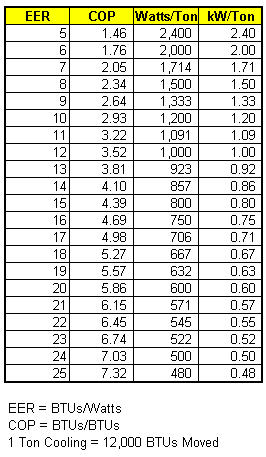 Gas engine driven equipment and absorption equipment is generally rated in COP and large tonnage electric chillers is rated in kW per Ton. It just takes a little basic math to convert between the two ratings in order to do an operating cost comparison. See the Table to the right. Space cooling equipment efficiency is mostly determined by the type of equipment that it is; general condition and cleanliness is a secondary factor. A general rule of thumb is that small DX equipment is the least efficient and larger water cooled equipment is the most efficient. If comparing new equipment, use the manufacturer’s specs; if comparing or attempting to estimate the operating cost of existing equipment, the following numbers can be used as a STARTING point:
Gas engine driven equipment and absorption equipment is generally rated in COP and large tonnage electric chillers is rated in kW per Ton. It just takes a little basic math to convert between the two ratings in order to do an operating cost comparison. See the Table to the right. Space cooling equipment efficiency is mostly determined by the type of equipment that it is; general condition and cleanliness is a secondary factor. A general rule of thumb is that small DX equipment is the least efficient and larger water cooled equipment is the most efficient. If comparing new equipment, use the manufacturer’s specs; if comparing or attempting to estimate the operating cost of existing equipment, the following numbers can be used as a STARTING point:
- Small DX equipment = EER = 5 to 7, COP = 1.5 to 2.0
- High Efficiency small DX equipment = EER = 10 – 14, COP 2.9 – 4.1
- Water Cooled Screw Chillers = 1.0 to 0.75 kW per ton
- High Efficiency Centrifugal water cooled chillers = 0.6 – 0.45 kW per ton
- Absorption Single Stage = COP 0.5
- Absorption Double-Effect = COP 0.9 – 1.2
- Engine Driven Chillers = COP 1.2 to 1.7
Consider Efficiency Improvements
If the heating system is older but in reasonably good condition, there are some things that could be added that may increase its efficiency by a few percentage points. However, system replacement is the only way to achieve substantial savings in most situations. Cooling systems do not have many options for efficiency upgrades. Other than keeping them clean and in good running condition, their efficiency is pretty much determined by their design at the time that they were manufactured. See HVAC Practices and HVAC Measures for efficiency improvement options.
Maintenance Needs
While looking at HVAC equipment, a lot can be learned about the general condition of the equipment. Does it appear to be in good condition and well maintained or neglected. It’s generally a good assumption to think that what’s seen and what’s not seen are in similar condition. Below are a few examples of what can be found in an HVAC equipment audit.
|
|
|
|
|
Dirty Coils on outside A/C Unit restricts air flow and reduces efficiency. |
HVAC Units Installed on a roof without curbs or seals. Dirt is collecting and weeds growing that will eventually damage roof and is probably already leaking some water. |
Rooftop HVAC unit installed with a poorly designed side air discharge instead of a vertical return and discharge. This type of unit is supposed to be used on the ground; increases air resistance through unit, but otherwise probably works OK. |
|
|
|
 |
|
A temperature sensor has fallen from its mount |
Disconnected ducts and pipes |
Failed and disconnected equipment |
|
|
|
|
|
A properly installed condensate drain on a rooftop HVAC unit |
A broken condensate drain that allows condensate to back-up into the unit |
When condensate backs-up into the unit, it generally leaks down onto the ceiling below, causing stains on the tile and potentially other water damage |
System Replacement Options
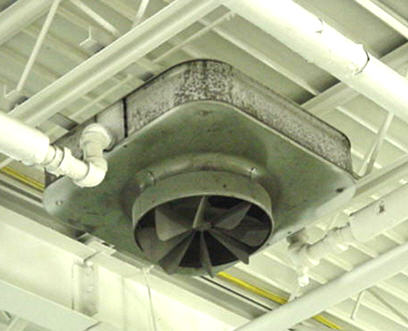 Old facilities with old heating systems are good candidates for heating system replacement. For industrial facilities, often the facility use changes and the heating system remains the same. What may have been appropriate for one use, may no longer be appropriate for the existing use. This is common with facilities that used to include a steam manufacturing process and therefore included a steam space heating system. If the process is long gone, then it’s time to think about replacing the steam heating system. If the facility has grown over the years, with small unit heaters added like a patch-work quilt as the facility grew, then it’s time to consider a central heating system. Old systems, such as steam, are costly to maintain and are inefficient when operated at a fraction of the load they were designed to deliver. Small heaters trying to heat a large facility are inefficient, costly to maintain, and cannot be reliably controlled. Spend some time reviewing the types of heating systems available. Consider the pros and cons of each system for the application. Start with the overviews in Space Heating. If it looks like heating system replacement is going to be a viable option, bring in some local vendors for discussion and quotes; it will not be cheap and the payback period will be measured in years, but it may be the only way to substantially deal with heating costs. Be sure to also consider the value of reduced maintenance and improved employee comfort in any payback analysis.
Old facilities with old heating systems are good candidates for heating system replacement. For industrial facilities, often the facility use changes and the heating system remains the same. What may have been appropriate for one use, may no longer be appropriate for the existing use. This is common with facilities that used to include a steam manufacturing process and therefore included a steam space heating system. If the process is long gone, then it’s time to think about replacing the steam heating system. If the facility has grown over the years, with small unit heaters added like a patch-work quilt as the facility grew, then it’s time to consider a central heating system. Old systems, such as steam, are costly to maintain and are inefficient when operated at a fraction of the load they were designed to deliver. Small heaters trying to heat a large facility are inefficient, costly to maintain, and cannot be reliably controlled. Spend some time reviewing the types of heating systems available. Consider the pros and cons of each system for the application. Start with the overviews in Space Heating. If it looks like heating system replacement is going to be a viable option, bring in some local vendors for discussion and quotes; it will not be cheap and the payback period will be measured in years, but it may be the only way to substantially deal with heating costs. Be sure to also consider the value of reduced maintenance and improved employee comfort in any payback analysis.
Ventilation Systems
The most expensive part of heating (and cooling) industrial facilities is the large amounts of fresh air that typically must be brought into the facility. This may also be true for other types of facilities, such as office complexes – if the facility is relatively new (built to ASHRAE indoor air quality standards) and includes central power ventilation. NOTE: Be sure to notice blocked vents, especially if they were designed to provide fresh air make-up to heating systems. It is common to find blocked air vents in furnace and boiler rooms. Maintenance workers often block these vents to reduce drafts and make the space warmer – especially if they must work in or near the space. This could be starving the heating system for air, resulting in reduced efficiency, sooting, and even the production of carbon monoxide. For more information see Ventilation Systems Source: Text Bob Fegan 10/2004; photos by Bob Fegan; Rev 1/2009;
© 2008 Energy Solutions Center400 N. Capitol Street NWWashington, DC 20001 All rights reserved. Legal Contact our webmaster

